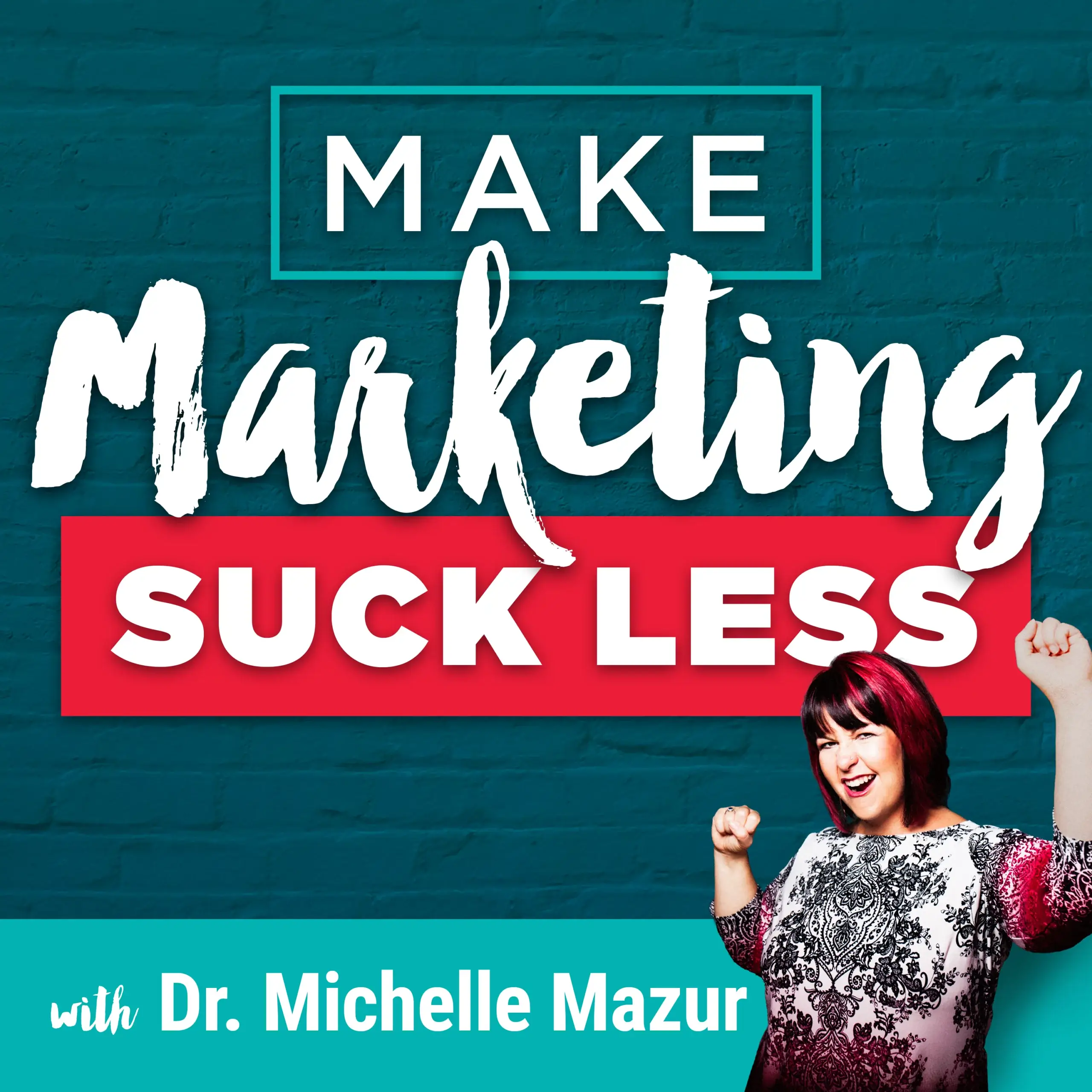Make Marketing Suck Less
Why You Should Ditch Ideal Client Avatars & Do This Instead
By Michelle Mazur > October 12, 2021
Filed Under Podcast

Truth time: How many ideal client avatars have you created for your business?
If I had to guess, probably a crap ton, right?
Every business program wants you to do one and they all sound something like this, “Makayla is a 38 year old entrepreneur and a mom to three cats. She loves watching highbrow TV shows like Better Call Saul, Schmigadoon, For All Mankind, and the boys. She's also into 80s music and still has a poster of her favorite band in her office.”
ALSO: Makayla doesn't freaking exist. She's a figment of your imagination.
Do you know who you can't market or sell to? People who don't freaking exist.
So let's burn all of those ideal client avatars, let's burn them to the ground and start paying attention to what actual clients say and have conversations with actual people. Here's three steps you can take to find out who you should actually be selling to.
- Think about your top 3 favorite clients of all time,
- Identify the problem they hired you to solve,
- Note down what results they are after.
I'm sharing more about this on the Rebel Uprising podcast today!
Tune in or read through the transcript below:
Episode resources:
RU 257 Why You Should Ditch The Ideal Client Avatar & Do This Instead
Truth time. How many ideal client avatars have you created for your business? A crap ton, right? Every business program wants you to do one and they all sound something like this. Makayla is a 38 year old entrepreneur and a mom to three cats. She loves watching highbrow TV shows like Better Call Saul, Schmigadoon, For All Mankind, and the boys. She's also into 80s music and still has a poster of her favorite band in her office. Also, Makayla doesn't freaking exist. She's a figment of my imagination.
Do you know who you can't market or sell to? People who don't freaking exist. So let's burn all of those ideal client avatars, let's burn them to the ground and start paying attention to what actual clients say and have conversations with actual people.
So how do you do this? How do you make this useful in your marketing, your messaging and your sales? That's what we're diving into on today's episode.
So, if you decided to listen on after that introduction, you are probably sick and tired of creating ideal client avatars because they probably have not been all that useful in your business. I know they have not been useful in mine. In fact, Makayla is pretty much me except a few years younger.
So how can we create something more real, more useful, and more meaningful for our business?
Now, one part of the work I do with clients is what I called an audience deep dive. The deep dive produces a client empathy map. So what is an empathy map? It is an idea that comes from tech and SaS companies, and it was created by a consulting team. What an empathy map helps us with is to better visualize and connect and understand the experience of the end user in tech.
But for us, we can think about it as what our clients are experiencing and the empathy map, specifically dives into what your clients are thinking, saying, and doing. What are their challenges? What are they struggling with and what are their goals like, where do they want to go next?
For this to be truly effective, we need to take this in three different steps because it's a deep dive into actual people. That's right. You want to base this on actual people and here's how you can start creating your own client empathy map based on real people. And guess what? This works, even if you don't have a shit ton of clients, yet you don't need to, you can do this with very few clients that you've worked with. So here are some of the initial steps that you can take to create eight an empathy map.
So step one is to think about who are your top three best clients of all time. Like, I know you shouldn't have favorite clients, but we all do. They're just clients that we're excited to work with. They're the clients that we say, oh my gosh, if I could clone Sheila, I totally wouldn't do that because I just want all of my clients to be exactly like her.
So write down their names and then start asking yourself some questions like what did you love about working with them? What made it so exciting for you? What did they have in common with each other?
Sometimes it feels like you're not recalling anything in common with each other, but that is never true. There's always a golden thread that goes through all of your best clients. Like I know this better than anyone else, because I have worked in, I don't know, 20 plus different industries with the 3 Word Rebellion framework and all of my clients have something in common. It's their creativity, their innovation, their smarts, the fact that they're doing something that is new, unique and different and difficult to talk about. Or, they're multi-passionate types and they're combining all these different methods together to produce great results.
So think about the things that make your clients alike and also think about how they are dissimilar from each other because that can also give you some great insight into who these people are and how they are alike. And that makes it so much easier to market when you're actually marketing to a real person and not a figment of your imagination.
Okay. Step two. So you have your clients in mind, you've done some initial things, like brain dumping about who they are, how they're alike, how they're dissimilar. The second thing you want to do is identify the problem they hired you to solve.
What I don't want you to do is recall this from your brain, because you are probably sitting on a ton of client language, you know, insights into what they were thinking, feeling doing before they hired you.
So I want you to go back into your top three files, look at their intake forms, listen to their recordings, and see how they were describing their problems. Note their specific language, see where they were trying to go, because this is the core of the empathy map, right? The goals, what they're struggling with, what they feel, see, hear, and do get this from their own language and how they talk about. It is going to make a world of difference.
Finally, step three, as you're going through these files, note down what results they are after. This helps you figure out what they want.
So for example, I got an intake form not too long ago and this one line just stood out to me, is that a podcast host said to this person, like, “I love you and I love to have you on my podcast, but I don't know what we would talk about.”
That is real language that I can actually use in my marketing and my copy. So while you're in those client files, look at what they wanted to accomplish by doing this work and how they talk about the results they're seeking and completing these three steps gives you a more robust picture of who your clients are. It makes it easier for you to empathize with them so that when you're creating your message you know the exact person you're talking to, and that person is very, very real. And when we have this language, this empathy map, it makes creating a sales page a breeze, because you have a lot of the language that you need to use.
So if you're thinking, okay, Michelle, this audience deep dive empathy map thing sounds amazing. And I'm not going to do it for myself. If you want me to create your client empathy map, that is one of the things that we do in the 3 Word Rebellion Messaging Intensive. In fact, that's where I always start. With my clients before we can create a message that resonates and moves people to want to hire you. We really have to understand who it is we're talking to, what makes them lean in and want to know more?
So if that sounds fascinating to you, you can get all the information about working with me 1:1 and download the service and pricing guide. It gives you a great overview of who is this work for? If you're ready for this work and the deets on the services and price prices of the services themselves.
So you can go to drmichellemazur.com/guide to download the pricing guide and get the link to book a call with me. I look forward to talking to you about your people.
Remember, the truth is you have to base your client profiles on real people, not imaginary avatars, those will always ring somehow false and won't bring you the right clients to your business. And when you focus on real people, this allows you to create copy and marketing that actually resonates and speaks the language of your client.
Sign up to receive email updates
Enter your name and email address below and I'll send you periodic updates about the podcast.
Create Your One-of-a-Kind Message
Your 3 Word Rebellion is the Key to Growing Your Business & Impact






